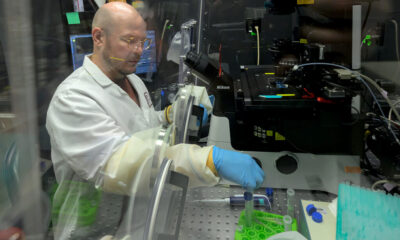Science
Wearable Sensors Could Reduce Fatal Racehorse Injuries by 20%

A groundbreaking study led by researchers at Washington State University reveals that a small wearable sensor designed for thoroughbred racehorses could potentially reduce fatal injuries by 20%. This innovative technology aims to identify horses at an elevated risk of catastrophic injury, which has long been a critical concern within the horse racing industry.
The research highlights how these sensors monitor various physiological parameters, allowing trainers and veterinarians to take proactive measures. By detecting changes in a horse’s movement and vital signs, the technology can flag potential issues before they escalate into serious injuries.
Potential Impact on Horse Racing
Injuries among racehorses have been a persistent challenge, with many cases resulting in irreversible damage or death. The implementation of these sensors could mark a significant advancement in equine health and injury prevention. The researchers believe that early detection and intervention could not only save lives but also enhance the overall welfare of racehorses.
According to the study, the sensors are lightweight and designed for comfort, making them suitable for daily use during training and races. Their ability to provide real-time data means that trainers can make informed decisions to adjust training regimens or seek veterinary assistance when necessary.
Future of Equine Technology
As the horse racing industry grapples with concerns over animal welfare and injury rates, this technological advancement presents a promising solution. The potential reduction in injuries could lead to increased confidence among owners and trainers, ultimately benefiting the sport’s reputation.
The research, published in early 2023, emphasizes the importance of integrating technology into traditional practices. As the industry evolves, embracing such innovations could pave the way for a safer and more sustainable future for racehorses.
The study not only underscores the need for ongoing research into equine health but also highlights the role of technology in shaping the future of horse racing. With further development and implementation, these sensors could become a standard in the industry, redefining how trainers approach injury prevention.
In summary, the findings from Washington State University offer hope for a significant reduction in fatal racehorse injuries. By leveraging technology to enhance monitoring and early intervention, the horse racing industry has the opportunity to prioritize the health and safety of its athletes.
-

 Technology4 months ago
Technology4 months agoDiscover the Top 10 Calorie Counting Apps of 2025
-

 Health2 months ago
Health2 months agoBella Hadid Shares Health Update After Treatment for Lyme Disease
-

 Health3 months ago
Health3 months agoErin Bates Shares Recovery Update Following Sepsis Complications
-

 Technology3 weeks ago
Technology3 weeks agoDiscover 2025’s Top GPUs for Exceptional 4K Gaming Performance
-

 Technology2 months ago
Technology2 months agoElectric Moto Influencer Surronster Arrested in Tijuana
-

 Technology4 months ago
Technology4 months agoDiscover How to Reverse Image Search Using ChatGPT Effortlessly
-

 Technology4 months ago
Technology4 months agoMeta Initiates $60B AI Data Center Expansion, Starting in Ohio
-

 Technology4 months ago
Technology4 months agoRecovering a Suspended TikTok Account: A Step-by-Step Guide
-

 Health4 months ago
Health4 months agoTested: Rab Firewall Mountain Jacket Survives Harsh Conditions
-

 Lifestyle4 months ago
Lifestyle4 months agoBelton Family Reunites After Daughter Survives Hill Country Floods
-

 Technology3 months ago
Technology3 months agoUncovering the Top Five Most Challenging Motorcycles to Ride
-

 Technology4 weeks ago
Technology4 weeks agoDiscover the Best Wireless Earbuds for Every Lifestyle













